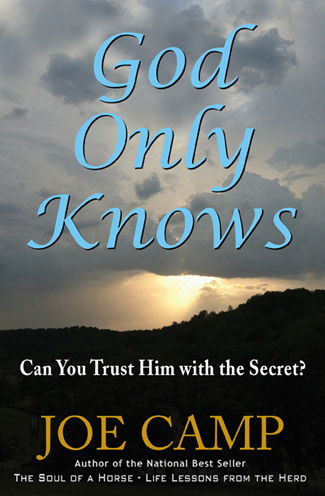Yay! Amazon is now running a free promotion for the Kindle edition of God Only Knows – Can You Trust Him with the Secret? Free, for three days only. Learn how the original Benji movie was made and distributed without any help from Hollywood, yet wound up the number 3 movie of the year. Learn how that film career morphed into the National Bestselling book The Soul of a Horse – Life Lessons from the Herd. And 12 other bestselling books. See God’s hand at work up close and personal.
Archive for July 2016
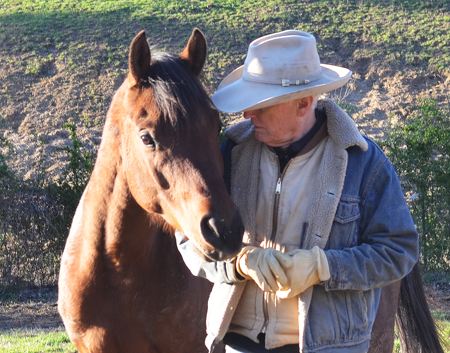
I allowed my very first horse to choose me. To tell me that he trusted me to be his leader. Not the other way around. It was his choice. And when it happened everything changed. For me, and my horse. He was no longer my horse. I wasn’t his owner. The first line of the movie Hildago said it right. Cash was now my little brother.
And I promised him that day that he would have the best life I could possibly give him. And I meant it. The problem was I had no idea what that best life was. But no stone would be left unturned because I now cared deeply about this horse and I would be asking everywhere I went how do I make his life better. Not how do I make my life better. My life would get better when his did. Read More→
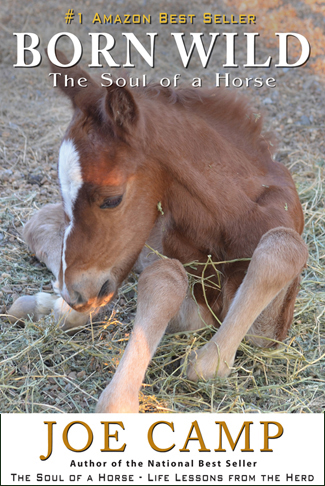
I’m excited! Amazon has another of our books on super sale! This time it’s the one I would most want you to read: Born Wild, the rest of the story. It begins where “The Soul of a Horse” left off, but with four more years of knowledge and experience. All 247 pages of our continuing journey and that of the golden stallion’s wild herd are on sale right now on Kindle for 99 cents, but only for the next three days! An Amazon #1 Bestseller; 4.5 stars!
Born Wild – The Soul of a Horse on Amazon
“I couldn’t imagine how Joe would top The Soul of a Horse, but he did! I just finished Born Wild. I could not put it down!” – Yvonne Rawleigh
“This book brings it home. Hated to put it down. Profound.” – J. Canfield
“Joe’s understanding and empathy for horses always amazes me…and his ability to translate it to us is equally amazing. So beautiful.” Cate Crismani – True Cowboy Magazine
“Thank you, Joe Camp, for loving so deeply and for being so passionate!” – Ruth Swander
“Joe Camp is a master storyteller.” – The New York Times Read More→
Comments (0)
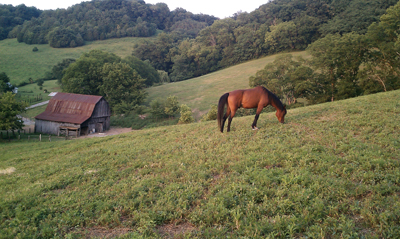
No more soy. No more GMO. A brand new diet for our Herd.
The subject of equine diet and nutrition is a very slippery slope, as anyone who has tried to make sense out of it can testify. This page is crammed full of everything we’ve learned about diet, nutrition, sugars, fats, soy, and supplements including exactly how we feed our seven wonderful beasties. Updated regularly. Worth a bookmark.
We continue to learn every day about how we can ensure that our horses are getting, or have access to, the kind of options they would have available to them in the wild, which is the foundation of their genetic structure – and our approach to everything equine – to ensure that our horses have access to what they need, and, at least to some extent, can also pick and choose what they feel they need based upon their individual conditions. As is highlighted throughout our books and this site, for us, it’s not about what we humans think, or what is most convenient for us. It’s about how we can replicate as closely as possible the health and happiness our horses would have if they were in the wild taking care of themselves. Below I’ll cover how we were feeding in our dry high desert home in southern California, then how we made the transition to middle Tennessee. But first, for those who would rather cut straightaway to exactly what were are doing today, I’ll do just that. But there’s value in reading through the history and understanding how we arrived at “today,” which is giant steps closer to my goal of seeing our horses live happily and healthily into their thirties and forties.
At this writing, we have initiated a brand new diet for our herd. No more soy. No more GMO. No more grains which turn to sugar, no more unbalanced Omega 6s (Creates inflammation!!), and no more artificial (chemical) preservatives.
Just when you think you’ve got it all exactly right someone comes along and says Not so fast young man.
And, as luck would have it, this was someone we trusted.
As many of you know, Triple Crown Safe Starch has been the foundation for whatever supplements we feed our horses for many years now. The product is a grass forage (orchard and timothy) that is guaranteed to be less than 10% NSC (non-structured carbs – sugar!). So it made sense to us back when we discovered the product because grass or grass hay is what horses should be nibbling most waking hours of their day. Grass forage has to be better than pellets, right? But our friend, Dr. Mark DePaolo, a terrific holistic vet, sauntered by and essentially said: Not if there is soy in the forage.
“Soy?” said I. “Why would there be soy in a forage? And is soy really bad for horses?”
Here is Dr DePaolo’s response:
“Why is there soy in horse feed? At this time, soy is the cheapest form of protein available. So, cost is the reason. But soy is highly estrogenic and should never be fed to either sex of horses, especially those that are already suffering from any type of metabolic disorder like Hypothyroidism, Insulin Resistance or Cushing’s Syndrome.
99.9% percent of soy included in human and horse food is genetically modified to be Round-Up Ready. Glyphosate, one of the active ingredients (in Round Up), is the leading cause of leaky gut syndrome in horses. Leaky gut syndrome can cause food allergies, diarrhea, mal-absorption syndrome, colic and irritable bowel syndrome.
Phytates in soy are also undesirable. They will bind to certain nutritional minerals in a horse’s diet and prevent them from being absorbed into the body. It is very common for a horse that is being fed soy to be lacking Iron, Manganese, Chromium, Cobalt and sometimes Selenium when tested utilizing Horse Hair Analysis. These minerals are very important in the production of proteinaceous connective tissues such as tendon, ligament, joint cartilage, hoof and hair coat.
Nutritional Minerals are also hugely significant portions of a healthy immune system, without them horses are more prone to damage from foreign invaders and pathogens that can cause Lyme disease, EPM, respiratory tract infections, etc. For your horse to be as healthy as possible you should be vigilant in eliminating any and all forms of soy from the feed and supplements that you give.”
It turns out that there is soy oil in Safe Starch and soy meal in the supplement that is added to Safe Starch to make the product a “complete feed”. We haven’t been feeding very much of it per day (approximately a half-pound), just enough to provide a base for our other supplements, but Dr. DePaolo convinced me that all soy should be avoided.
So we switched to Triple Crown Premium Chopped Grass Forage (also guaranteed to be less than 10% NSC) which neither contains soy oil nor any supplements, meaning no soy meal. And no wheat middlings, another item Dr. DePaolo is not fond of because of its glycemic rating (sugar).
To the forage, we add Omega Fields’ Omega Horseshine, one-half cup to 2 cups per day depending upon the horse and the moment. At this writing one is receiving 2 cups per day, three horses are receiving 1 cup per day, the rest one-half cup per day. This is the singular best Omega 3 supplement on the market as far as I’m concerned. It has an unbelievably low NSC rating of 4.4 (a measure of Non-structural carbs, which turn to sugar immediately upon entering the horse’s body). And Horseshine is the only major brand Omega 3 supplement on the market that is 99.9% pure Non-GMO human-food grade stabilized flax! This is very best stabilized ground flax, using proprietary flax stabilizing technology that preserves the nutritional value of the Omega 3s. Every domestic horse on the planet needs Omega 3 supplementation because no one, horse or human, can manufacture their own Omega 3s. A horse in the wild will get his Omega 3 needs from the many varied kinds of fresh native grasses that have never been exposed to chemical fertilizers, pesticides, herbicides, and never been GMO’d. Domestic pastures virtually always come up short because usually they have been exposed to one or all of the above. And hay loses its Omega 3s when it’s cut and dried, so the horse (and the human) need Omega 3 supplementation. If you are currently supplementing Omega 3 using another product, I encourage you to read the label. I have for every major Omega 3 product out there. You will find no other brand using human-food-grade flax. And virtually every other Omega 3 product will contain some sort of sugar or molasses, and/or grains that are high in non-structural carbs that turn into sugar immediately once inside your horse and are loaded with unbalanced Omega 6s which create inflammation in your horse (corn and corn by products, wheat and wheat by products, barley, etc), and/or partially or totally hydrogenated vegetable oils (which create inflammation inside your horse), soy (see above), and artificial (chemical) preservatives. Omega Fields seriously cares about all health concerns of your horse and has addressed them in Omega Horseshine. As you can tell, I am truly excited to find these people! And to learn that Omega 3s are absolutely essential to our horses. They fight inflammation, they support and build the immune system, improve bone and joint health, restore cracked and brittle hooves and support strong solid hoof growth, can eliminate sweet itch and bug-bite sores, and promote shiny, healthy coats and smoother skin texture, and more! Stormy looks like she has been shellacked. Seriously. It’s the shiniest winter coat I’ve ever seen.
Oh, and there’s no need to worry about over-doing Omega 3s. Neither you nor your horse can get too many Omega 3s (unless you’re on a blood-thinning medication, in which case stick closely to recommended dosages). And read about Omega Fields’ Omega Nibblers – Low Sugar treats. The one treat on the planet that is actually good for your horse.
Omega Horseshine and the following minerals are now the only supplementation we do.
All the horses get Bloomin Minerals, some in their feed and some from free-feeding. In my opinion these are the best complete essential minerals for horses and a really inexpensive way to get all 71 of nature’s essential minerals, in nature’s balance, working in the bodies of your beloved animals, boosting their immune systems and helping them to make themselves healthy. To prime the pump so to speak, we wet down 1/3 cup of the minerals and stir them into their morning chopped forage. Once dispersed the minerals stick to the chopped forage and are eaten with no issues. And that causes them to look to the free-choice bucket if their bodies say we need more. The nice thing about plant derived colloidal minerals is there’s no such thing as overdosing. The body takes what it needs and disposes of the rest. Click here to read more about Bloomin Minerals.
We still are feeding California Trace which is basically a supplement emphasizing copper, zinc, and selenium, very important minerals to the thyroid, pituitary gland and other organs. Our soils are virtually void of those three. In fact the soils in most of our country are badly depleted of those three minerals. Skeeter was able to eliminate his pharmaceutical thyroid medicine altogether once he was getting California Trace.
Dr. Dan’s Red Cal is our free choice salt and trace mineral mix.
We also use Diatomaceous Earth (DE), again stirred into the chopped forage, for parasite prevention (see our post No More Poison – Life Without De-Wormers).
We add in a half-cup of alfalfa pellets, basically just for the “crunch” and that’s it.
There you have it. As you know, our herd is out 24/7, so they have free-choice grass and/or Bermuda hay (quantity dependent upon the time of year) around the clock. Very important! In fact, one of the most important things your can do for your horse. This is a must because, in the wild, horses are moving and eating 12-18 hours a day. Their tiny tummies (comparatively speaking) need to be eating little bits of grass or grass hay pretty much all the time. Horses are genetically programmed to eat grass forage (real grass or grass hay), little bits at a time, up to 18-20 hours a day. Unlike the human’s, the horse’s stomach is programmed to release digestive acid around the clock. When grass forage is not dribbling in on a regular basis the acid has nothing to work on but the insides of the horse itself! The acid is in the stomach, where it can reach the upper squamous region that has no protective mucus lining, which is where most ulcers form. Human digestive acid turns on and off depending upon whether food is present. The horse’s digestive acid never stops. So the grass forage needs to be there. Free-choice. Around the clock. Our guys and gals have just celebrated their seventh anniversary out on pasture 24/7 in middle Tennessee, where legend has nicknamed our new homeland Founder Valley. Done right, it isn’t. You can read about all that in the post or the book Horses Were Born to be on Grass. Suffice to say they are all happy, healthy, and without issue.
And… for those who just want a list without all the related thoughts and stories, here ‘tis:
Triple Crown Premium Chopped Grass Forage
Omega Fields’ Omega Horseshine
Youngevity Bloomin Minerals – free choice
Dr. Dan’s Red Cal – free choice
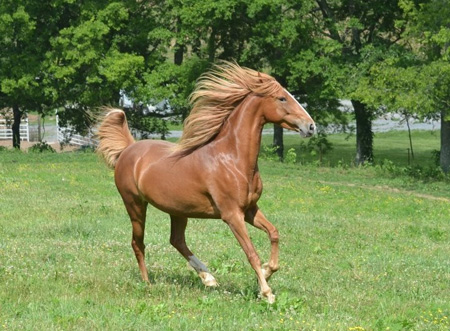
Skin and bones when we rescued her at 7 months from
an awful confinement in Iowa. Now Miss Mouse is
a beautiful, healthy, happy young lady.
The Kentucky Equine Research Staff reports in a recent EquiNews that confinement weakens bones in horses.
“Bone is a dynamic, living tissue strengthened through use. Impact stress from moderate exercise—whether it’s a structured regime such as daily training or simply roughhousing in a pasture—encourages osteoblasts to lay down osteoid tissue, which is converted into healthy, resilient bone.
“When a horse does not exercise regularly, osteoids grow lazy, refusing to deposit substrate for skeletal renewal, and eventually mature bones will demineralize. Over time, demineralization weakens individual bones, which in turn reduces the strength of the entire skeleton. For maximal skeletal resiliency, horses should exercise daily, be it in a tailored training setting or just cruising in a pasture with friends.”
A horse in the wild will move anywhere from 8 to 20 miles per day. A horse in a stall, by study, will average only 800 steps per day. The equine body and brain Read More→















Copyright © 2024 All Rights Reserved
